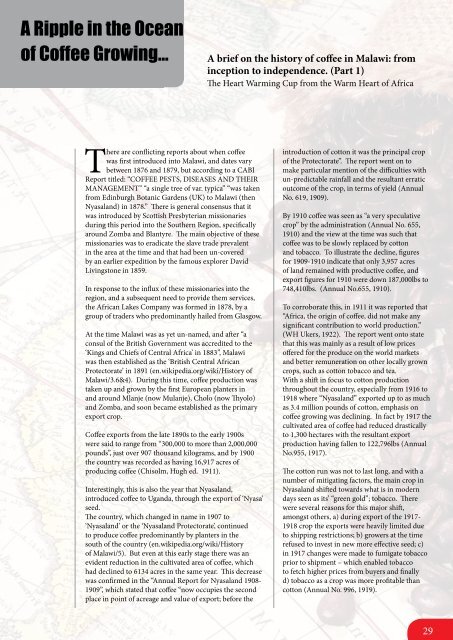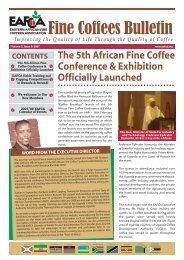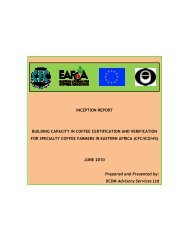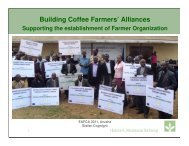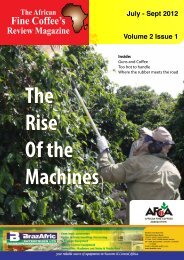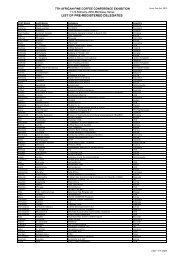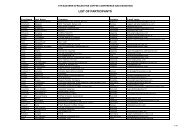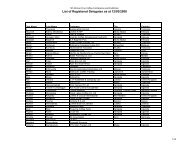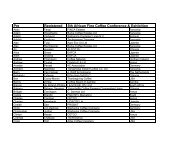African Fine Coffees Review Special Edition Oct-Dec - EAFCA
African Fine Coffees Review Special Edition Oct-Dec - EAFCA
African Fine Coffees Review Special Edition Oct-Dec - EAFCA
You also want an ePaper? Increase the reach of your titles
YUMPU automatically turns print PDFs into web optimized ePapers that Google loves.
A Ripple in the Ocean<br />
of Coffee Growing… A brief on the history of coffee in Malawi: from<br />
inception to independence. (Part 1)<br />
The Heart Warming Cup from the Warm Heart of Africa<br />
There are conflicting reports about when coffee<br />
was first introduced into Malawi, and dates vary<br />
between 1876 and 1879, but according to a CABI<br />
Report titled: “COFFEE PESTS, DISEASES AND THEIR<br />
MANAGEMENT” “a single tree of var. typica” “was taken<br />
from Edinburgh Botanic Gardens (UK) to Malawi (then<br />
Nyasaland) in 1878.” There is general consensus that it<br />
was introduced by Scottish Presbyterian missionaries<br />
during this period into the Southern Region, specifically<br />
around Zomba and Blantyre. The main objective of these<br />
missionaries was to eradicate the slave trade prevalent<br />
in the area at the time and that had been un-covered<br />
by an earlier expedition by the famous explorer David<br />
Livingstone in 1859.<br />
In response to the influx of these missionaries into the<br />
region, and a subsequent need to provide them services,<br />
the <strong>African</strong> Lakes Company was formed in 1878, by a<br />
group of traders who predominantly hailed from Glasgow.<br />
At the time Malawi was as yet un-named, and after “a<br />
consul of the British Government was accredited to the<br />
‘Kings and Chiefs of Central Africa’ in 1883”, Malawi<br />
was then established as the ‘British Central <strong>African</strong><br />
Protectorate’ in 1891 (en.wikipedia.org/wiki/History of<br />
Malawi/3.6&4). During this time, coffee production was<br />
taken up and grown by the first European planters in<br />
and around Mlanje (now Mulanje), Cholo (now Thyolo)<br />
and Zomba, and soon became established as the primary<br />
export crop.<br />
Coffee exports from the late 1890s to the early 1900s<br />
were said to range from “300,000 to more than 2,000,000<br />
pounds”, just over 907 thousand kilograms, and by 1900<br />
the country was recorded as having 16,917 acres of<br />
producing coffee (Chisolm, Hugh ed. 1911).<br />
Interestingly, this is also the year that Nyasaland,<br />
introduced coffee to Uganda, through the export of ‘Nyasa’<br />
seed.<br />
The country, which changed in name in 1907 to<br />
‘Nyasaland’ or the ‘Nyasaland Protectorate’, continued<br />
to produce coffee predominantly by planters in the<br />
south of the country (en.wikipedia.org/wiki/History<br />
of Malawi/5). But even at this early stage there was an<br />
evident reduction in the cultivated area of coffee, which<br />
had declined to 6134 acres in the same year. This decrease<br />
was confirmed in the “Annual Report for Nyasaland 1908-<br />
1909”, which stated that coffee “now occupies the second<br />
place in point of acreage and value of export; before the<br />
introduction of cotton it was the principal crop<br />
of the Protectorate”. The report went on to<br />
make particular mention of the difficulties with<br />
un-predictable rainfall and the resultant erratic<br />
outcome of the crop, in terms of yield (Annual<br />
No. 619, 1909).<br />
By 1910 coffee was seen as “a very speculative<br />
crop” by the administration (Annual No. 655,<br />
1910) and the view at the time was such that<br />
coffee was to be slowly replaced by cotton<br />
and tobacco. To illustrate the decline, figures<br />
for 1909-1910 indicate that only 3,957 acres<br />
of land remained with productive coffee, and<br />
export figures for 1910 were down 187,000lbs to<br />
748,410lbs. (Annual No.655, 1910).<br />
To corroborate this, in 1911 it was reported that<br />
“Africa, the origin of coffee, did not make any<br />
significant contribution to world production.”<br />
(WH Ukers, 1922). The report went onto state<br />
that this was mainly as a result of low prices<br />
offered for the produce on the world markets<br />
and better remuneration on other locally grown<br />
crops, such as cotton tobacco and tea.<br />
With a shift in focus to cotton production<br />
throughout the country, especially from 1916 to<br />
1918 where “Nyasaland” exported up to as much<br />
as 3.4 million pounds of cotton, emphasis on<br />
coffee growing was declining. In fact by 1917 the<br />
cultivated area of coffee had reduced drastically<br />
to 1,300 hectares with the resultant export<br />
production having fallen to 122,796lbs (Annual<br />
No.955, 1917).<br />
The cotton run was not to last long, and with a<br />
number of mitigating factors, the main crop in<br />
Nyasaland shifted towards what is in modern<br />
days seen as its’ “green gold”; tobacco. There<br />
were several reasons for this major shift,<br />
amongst others, a) during export of the 1917-<br />
1918 crop the exports were heavily limited due<br />
to shipping restrictions; b) growers at the time<br />
refused to invest in new more effective seed; c)<br />
in 1917 changes were made to fumigate tobacco<br />
prior to shipment – which enabled tobacco<br />
to fetch higher prices from buyers and finally<br />
d) tobacco as a crop was more profitable than<br />
cotton (Annual No. 996, 1919).<br />
29


